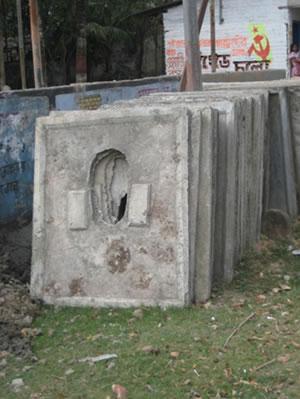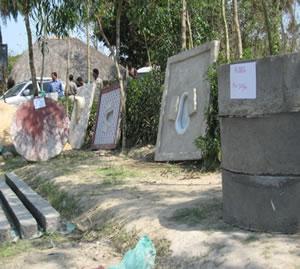A study is now circulating about how more people in India have access to cell phones than latrines. This lit up the blogosphere and Twitter – sector professionals and advocates are both dumbfounded and outraged that something so central to health and development as a toilet is being numerically lapped by something so trivial/consumerist as a cell phone. This affront has led to yet further calls for "action": more money for toilets and greater commitments to sanitation provision from aid agencies, governments, and NGOs who too often prioritize water over sanitation.
Let’s step back for one moment. It’s certainly a disaster that sanitation coverage still lags so far behind almost everything else in the development sector. But are we really surprised by this situation in India? Cell phones are pretty cool; there are a plethora of cell phone options and a wide variety of cell phone providers, with varying payment plans to meet a wide variety of people’s needs. Cell phones are functional and allow people to stay in touch with family, friends, and business associates. Cell phones are proving to be critical instruments to transfer money in places like Kenya, and to keep track of bank balances in many developing countries. They are fashion statements, status symbols and a source of prestige and pride. Extremely poor people have a cell phone for good reason – it has become a key part of some people’s efforts to escape poverty – something I have witnessed with surprise in places like rural Mozambique (where I am pretty sure cell phones also far outstrip latrines if anyone bothered to do the research).
In fact, cell phones are almost everything a toilet is not.
Sanitation activists can of course scream and yell about this all they want, but perhaps a better strategy that would actually help people without improved sanitation is to try and learn something from cell phones. Perhaps we can learn something that may begin to meaningfully spread sanitation, even without some "master plan" or vague "call to action"
Cell phone providers absolutely understand that a wide variety of choices matter. One person may want an iPhone, another may want a Droid. There are cell phones that are so basic that many of us laugh at their simplicity, and others so advanced that I can't turn them on. This diversity of technology options – and the diversity of messages surrounding each option – comes from a real effort by cell phone providers to understand their market. Providers understand that one option does not fit every customer, and that they need to make at least one set of options incredibly cheap while maintaining that phone’s allure and functionality if they want to link poorer people into their service networks.

Compare the variety of available cell phone options with sanitation options. Depressing actually if one thinks about it. Most sanitation programs – especially ones that have come from "action" plans – seem to assume everyone wants one type of toilet. The choice is most often that of a donor, or a government, or a NGO, or budding engineers who want to test a cool new design.
It’s almost never based on any sense of what a wide variety of people may want to consider on the ground. If you are involved in a project and have a personal passion for a ventilated improved pit latrine (VIP) then I can pretty much assure you that people will get a VIP. Ecological Sanitation (EcoSan) advocates may counter that composting EcoSan latrines are the "only option" communities should consider, and surprise surprise we have a community with composting toilets. Both of these are classic examples of specialists telling "them" (the communities) what "they" want, without providing options or variety of choice. This approach has led to sanitation moving at snail’s pace worldwide, as cell phones bound forward.
Travel through India and you can see SaniMarts like the one pictured above. Unattractive products, no variety, and really no shock that people are not interested. The hammer and sickle in the background of this picture is ironic but actually not misplaced in the photo. I would buy a cell phone over these "options" every time.
Despite the "action" rhetoric, sanitation programming is still uncreative and uninspiring, forcing a small range of choices (if any) down people’s throats and struggling to understand why sanitation does not "take off." I would bet that the number of sanitation projects worldwide that offer one option far outnumber the number of sanitation projects that offer a range of technical options, aesthetic improvements to these options that could lure people in, and/or payment plans that meet diverse household budgets and particular financial constraints, like the one depicted in the photo below.
 It is not hard to understand why this occurs – there are 2.6 billion people worldwide without access to improved sanitation. 2.6 billion – in mass, undifferentiated, and joined by the common trait of not having a toilet. There is almost no effort at market segmentation at all, or a sense that a community could include a range of people with different ideas, motivations and aspirations around sanitation. Cell phones understand market segmentation and have designed and marketed accordingly. Sanitation has not, and lagged behind as a result.
It is not hard to understand why this occurs – there are 2.6 billion people worldwide without access to improved sanitation. 2.6 billion – in mass, undifferentiated, and joined by the common trait of not having a toilet. There is almost no effort at market segmentation at all, or a sense that a community could include a range of people with different ideas, motivations and aspirations around sanitation. Cell phones understand market segmentation and have designed and marketed accordingly. Sanitation has not, and lagged behind as a result.
Click here for more details on Misguided Debate Continues to Shape Sanitation Crisis: Part one
Click here for Misguided Debate Continues to Shape Sanitation Crisis: Part Two
/articles/misguided-debate-continues-shape-sanitation-crisis-0